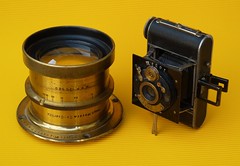Difference between revisions of "Meyer"
(takeover by OPC) |
m (Note a few lenses are engraved 'Hugo Meyer & Co. Goerlitz & New York'; ref to example.) |
||
| (9 intermediate revisions by 3 users not shown) | |||
| Line 1: | Line 1: | ||
{{Görlitz}} | {{Görlitz}} | ||
| + | <div class="floatright"> | ||
{{Flickr image | {{Flickr image | ||
| image_source=http://www.flickr.com/photos/89864432@N00/2583149835/in/pool-camerawiki | | image_source=http://www.flickr.com/photos/89864432@N00/2583149835/in/pool-camerawiki | ||
| Line 8: | Line 9: | ||
|image_rights= with permission | |image_rights= with permission | ||
}} | }} | ||
| − | + | </div> | |
| + | '''Meyer''' was a German optical company, founded in 1896 by Hugo Meyer in Görlitz. Besides [[Carl Zeiss Jena]] and [[Schneider Kreuznach]] it was one of the leading German lens makers in the 20th century. Meyer products were imported into the UK by the London company [[Roth]], while Meyer had a US company, Hugo Meyer & Co., Inc. of New York, and Meyer rangefinders for press cameras and some other accessories are US-made. A few (very few) German-made lenses are engraved for ''Hugo Meyer & Co., Görlitz & New York.''<ref>[https://www.photrio.com/forum/threads/hugo-meyer-dr-rudolph-double-plasmat.8893/ Double Plasmat] engraved for Meyer ''Goerlitz & New York'', in a forum post at Photrio. The spelling 'Görlitz' has also been seen, on lenses sold at Ebay.</ref> In 1946 Meyer became '''VEB Feinoptisches Werk Görlitz''' (state owned company) and was merged in 1968 onto [[Pentacon|VEB Pentacon Dresden]]. The name '''Meyer''' disappeared from the lenses in 1971, all were branded '''Pentaconar''', simple '''Pentacon''' or later '''Prakticar'''. After the German re-unification in 1990 the company had a short life as '''Feinoptisches Werk Görlitz GmbH''' until bankruptcy in 1991. In 2021 the brand '''Meyer Optik Görlitz''' was revived, with lens production in Hamburg, Germany, though (see below). | ||
| + | ==History== | ||
| + | <div class="floatright"> | ||
{{Flickr image | {{Flickr image | ||
| − | | image_source=http://www.flickr.com/photos/ | + | | image_source=http://www.flickr.com/photos/camerawiki/48712555796/in/pool-camerawiki |
| − | | image= | + | | image=https://live.staticflickr.com/65535/48712555796_5bc69d9479_m.jpg |
| image_align=right | | image_align=right | ||
| image_text=Plasmat | | image_text=Plasmat | ||
| Line 17: | Line 21: | ||
|image_rights= public domain | |image_rights= public domain | ||
}} | }} | ||
| − | '''Meyer''' | + | </div> |
| − | + | '''Hugo Meyer''' (born 21.05.1863, died 01.03.1905) did an apprenticeship as an optician in Potsdam (1878-1882) and later worked at [[Leitz|Ernst Leitz in Wetzlar]] (01.06.1885-01.02.1889). In 1894 he became factory manager at the ''Werkstätte für Präzisions-Optik Oscar Simon'' in Görlitz.<ref name="Thiele">{{Thiele Wer}}</ref> Oscar Simon moved his workshop to Dresden in 1896 and Hugo Meyer took the chance to establish his own company '''Optisch-mechanische Industrieanstalt Hugo Meyer &Co., Görlitz'''. His companion was the merchant Heinrich Schätze. <ref name="MO">[https://www.meyer-optik-goerlitz.com/en/history/ History section] at [https://www.meyer-optik-goerlitz.com/en Meyer Optik Görlitz Web-site]</ref> After his early death (41 years) his sons Hugo, Erich and Harry became joint owners and managed the company until 1945. | |
| − | |||
| − | |||
| − | |||
| − | |||
| − | |||
| − | + | The first patent of the company (DRP 125.560, 1.06.1900) <ref name="pat">[https://depatisnet.dpma.de/DepatisNet/depatisnet?window=1&space=menu&content=treffer&action=pdf&docid=DE000000125560A&Cl=2&Bi=1&Ab=&De=1&Dr=4&Pts=&Pa=&We=&Sr=&Eam=&Cor=&Aa=&so=asc&sf=vn&subdok=Page1&firstdoc=1&NrFaxPages=4&pdfpage=1 DRP125560] at [https://depatisnet.dpma.de/DepatisNet/depatisnet?window=1&space=menu&content=index&action=index&switchToLang=en German Patent and Trademark Office]]</ref> was about the 4-lenses anastigmat ''[[Aristostigmat]]'', which was offered initially with f/7.7, later f/6.8 and eventually with f/5.5. These lenses and the ''Schnellarbeiter'' (f/3) laid the foundation of the success development of the company. In November 1911 the competitor ''Schulze & Billerbeck'' was acquired, who just moved to Görlitz from Berlin one year before. Their ''Euryplan'' lens series was later added to the Meyer lens portfolio. <ref name="Thiele" /> | |
| − | In | + | In 1916 the ''Trioplan'' was launched, which became the basis for many Meyer lenses to follow. In 1918 [[Paul Rudolph|Dr. Paul Rudolph]], the inventor of [[Tessar|Zeiss' Tessar]] and Protar, developed Meyer's Double Plasmat which was derived from the symmetrical Euryplan lens. In the 1920s he developed fast variants, the Kino-Plasmat f/2 and the World's fastest lens of its time, the Kino-Plasmat f/1.5. Another important step was the delivery of OEM-lenses for camera manufacturers - such as the [[Exakta]] from [[Ihagee]]. In the 1930s Meyer-Optik already had a wide range of high-quality interchangeable lenses. Compared to [[Carl Zeiss Jena]], who was a market leader at the time, the lenses were usually offered at a slightly lower price. |
| − | In 2018 ''OPC Optics'', a maker of special lens elements based in Bad Kreuznach, bought the brand from the bankrupt net SE. | + | After WWII, in 1945 all machines and technical equipment were dismantled and taken to the Soviet Union. In 1946 a laborious rebuilding of production began and the company was nationalized under the new name '''VEB Feinoptisches Werk Görlitz'''. Initially, the lenses still carried the Brand ''Meyer-Optik''. Meyer was clearly the second East German lens supplier after [[Carl Zeiss Jena]]. In mid 1960s Meyer introduced lenses with interchangeable [[adapter]]s for different camera types. The first such a lens was Orestegor 4/200, which could be mounted on [[Exakta Varex]], [[Exa|Exa II]], [[Pentacon]], [[Praktina]] and [[Praktica]] 35 mm cameras with applicable adapters. Orestegor 5.6/500 could be mounted on Exakta Varex, Exa II, Pentacon, Praktina, Praktica as well as [[Praktisix]] medium format SLR. In 1968 Meyer became a part of VEB [[Pentacon]] and from 1971, all the Meyer lenses were branded '''Pentaconar''', simple '''Pentacon''' or later '''Prakticar'''. |
| + | |||
| + | After the German re-unification, Meyer-Optik was separated from the Carl Zeiss Jena combine and relaunched as ''Feinoptisches Werk Görlitz GmbH''. Lenses with the imprint Meyer-Optik were produced again for a short time until the company's bankruptcy in 1991. In 2014 the brand management company ''Globell'' revived the brand on the [[Photokina]]. Later the new technology company ''net SE'' announced the production of the new Meyer lenses in cooperation with original Meyer optics engineers from Görlitz. In 2018 ''OPC Optics'', a maker of special lens elements based in Bad Kreuznach, bought the brand from the bankrupt net SE. Since August 2021, '''Meyer Optik Görlitz''' has again been operating as an independent company (under the roof of OPC as parent company). Another important milestone was then in November 2021, the start of its own manufacture in the heart of Hamburg. <ref name="MO" /> | ||
| − | == | + | == Meyer lenses == |
For lens serial numbers see [[Meyer serial numbers | THIS page]]. | For lens serial numbers see [[Meyer serial numbers | THIS page]]. | ||
{|class=floatright | {|class=floatright | ||
| Line 107: | Line 108: | ||
* Somnium (fast special-bokeh portrait lens, rebadged and repriced [[42mm_screw_lenses#KMZ|Helios]] lenses) | * Somnium (fast special-bokeh portrait lens, rebadged and repriced [[42mm_screw_lenses#KMZ|Helios]] lenses) | ||
* Trioplan (classic portrait lens) | * Trioplan (classic portrait lens) | ||
| − | + | === See also === | |
| − | = | ||
| − | |||
| − | |||
| − | |||
| − | |||
| − | == See also == | ||
{{Flickr image | {{Flickr image | ||
| image_source=http://www.flickr.com/photos/kratz/3319168911/in/pool-camerawiki | | image_source=http://www.flickr.com/photos/kratz/3319168911/in/pool-camerawiki | ||
| Line 130: | Line 125: | ||
{{br}} | {{br}} | ||
| + | ==Cameras== | ||
| + | * [[Lunar]] | ||
| + | * [[Megor]] | ||
| + | * [[Silar]] | ||
| + | |||
| + | |||
== Cameras with a fixed Meyer lens == | == Cameras with a fixed Meyer lens == | ||
| Line 149: | Line 150: | ||
* Welta [[Welti]] 1 | * Welta [[Welti]] 1 | ||
| − | == | + | ==Other products== |
| + | {|class="floatright plainlinks" style="margin:0px 0px 20px 20px;"> | ||
| + | |{{Flickr image | ||
| + | | image_source=https://www.flickr.com/photos/camerawiki/5503104450/in/pool-camerawiki | ||
| + | | image=https://live.staticflickr.com/5218/5503104450_e81b5ea017_w.jpg | ||
| + | | image_align= | ||
| + | | image_text= Meyer coupled RF for folding-bed cameras<br/>''Popular Photography'' December 1945, p153.<br/> | ||
| + | | scan_by=Voxphoto | ||
| + | | image_rights= Public domain US no copyright | ||
| + | }} | ||
| + | |{{Flickr image | ||
| + | | image_source=https://www.flickr.com/photos/photoplastic/3130955303/in/pool-camerawiki | ||
| + | | image=https://live.staticflickr.com/3126/3130955303_ceabc6c6a5_w.jpg | ||
| + | | image_align= | ||
| + | | image_text= [[Busch Pressman Model D|Pressman]] with a Meyer coupled RF | ||
| + | | image_by=PhotoShop Guru | ||
| + | | image_rights= wp | ||
| + | }} | ||
| + | |} | ||
| + | * '''Coupled rangefinder''' for press/field cameras, such as the Busch Pressman shown here.<br/>The RF's lever arm bears on an attachment on the focus rails, so it doesn't require a 'rangefinder-coupled' lens. It was advertised for users to fit to their own camera. | ||
| + | {{Flickr image | ||
| + | | image_source=https://www.flickr.com/photos/camerawiki/6111573020/in/pool-camerawiki | ||
| + | | image=https://live.staticflickr.com/6066/6111573020_dbab90513d_n.jpg | ||
| + | | image_align=right | ||
| + | | image_text= Meyer Pocket RF.<br/>''US Camera'' Oct 1949, p110.<br/> | ||
| + | | image_by=camerawiki | ||
| + | | scan_by=steevithak | ||
| + | | image_rights= Public domain US no copyright | ||
| + | }} | ||
| + | *'''Pocket rangefinder''' | ||
| + | *'''Megoflex''' shoe-mounted focusing reflex finder for the [[Leica I]], [[Contax rangefinder|Contax]] and Nagel [[Pupille]]; effectively makes the viewfinder camera into a TLR; about 1930<ref>[https://www.leitz-auction.com/en/Leica-I-Mod.-A-Elmar-Goerlitz-Megoflex/AI-20220621-1414-41641 Megoflex] focusing reflex finder with a Leica I, sold at the [https://www.leitz-auction.com/en/Cameras/Past-Auctions/Auction-43/ 43rd Leitz Photographica Aution], in November 2023.</ref> | ||
| + | |||
| + | The 1936 US catalogue linked below lists focusing loupes, filters, supplementary lenses, tripod heads, accessory viewfinders and even front-mounted shutters. | ||
| + | <br style="clear:both;"/> | ||
| + | |||
| + | == Sources and References== | ||
| + | <references /> | ||
* Fincke H.E.: Das Objektiv deiner Kamera; Fotokinoverlag Halle, Halle, 1959. | * Fincke H.E.: Das Objektiv deiner Kamera; Fotokinoverlag Halle, Halle, 1959. | ||
* Naumann H.: Das Auge meiner Kamera; Verlag von Wilhelm Knapp, Halle (Saale), 1951. | * Naumann H.: Das Auge meiner Kamera; Verlag von Wilhelm Knapp, Halle (Saale), 1951. | ||
| Line 156: | Line 193: | ||
== Links == | == Links == | ||
| − | <div class=" | + | <div class="floatlright plainlinks" style="margin:0px 0px 10px 15px;"> |
{{Flickr image | {{Flickr image | ||
| image_source=http://www.flickr.com/photos/89864432@N00/4293418243/in/pool-camerawiki/ | | image_source=http://www.flickr.com/photos/89864432@N00/4293418243/in/pool-camerawiki/ | ||
| image=http://farm3.static.flickr.com/2784/4293418243_d6f6a17c55_m.jpg | | image=http://farm3.static.flickr.com/2784/4293418243_d6f6a17c55_m.jpg | ||
| − | | image_align= | + | | image_align=right |
| image_text= | | image_text= | ||
|image_by= Uwe Kulick | |image_by= Uwe Kulick | ||
| Line 166: | Line 203: | ||
}} | }} | ||
</div> | </div> | ||
| − | + | * [http://www.meyer-optik-goerlitz.de/de/geschichte/ History on company homepage] | |
| − | * [http://www.meyer-optik-goerlitz.de/de/geschichte/ | + | * Hugo Meyer prewar catalogues at [https://www.cameraeccentric.com/ Camera Eccentric]: |
| − | * [ | + | **[https://www.cameraeccentric.com/static/img/pdfs/meyer_1.pdf 1930 Cine lenses]: Kino-Plasmat, Trioplan, Tele-Megor and Makro-Plasmat |
| − | * [ | + | **[https://www.cameraeccentric.com/static/img/pdfs/meyer_3.pdf 1936 Catalogue of photo lenses] giving Roth of London as sole British agent. |
| + | **[https://www.cameraeccentric.com/static/img/pdfs/meyer_4.pdf 1936 US price list] of lenses and accessories incl loupes, tripod heads, shutters etc. | ||
| + | **[https://www.cameraeccentric.com/static/img/pdfs/meyer_2.pdf 1938 Photo and cine lenses]; eight-page advertising spread in the British Journal Almanac | ||
| + | **[https://www.cameraeccentric.com/static/img/pdfs/meyer_5.pdf 1952 Large-format lenses] (in German) | ||
* [http://www.mflenses.com/gallery/v/german/meyer/ Meyer Gallery] at [http://www.mflenses.com www.mflenses.com] | * [http://www.mflenses.com/gallery/v/german/meyer/ Meyer Gallery] at [http://www.mflenses.com www.mflenses.com] | ||
* [http://www.bolexcollector.com/lenses/40meyer.html Hugo Meyer cine lenses] company history and list of cine lenses | * [http://www.bolexcollector.com/lenses/40meyer.html Hugo Meyer cine lenses] company history and list of cine lenses | ||
* [http://www.stadtwiki-goerlitz.de/index.php?title=Hugo_Meyer Hugo Meyer] in Stadtwiki Görlitz (in German) | * [http://www.stadtwiki-goerlitz.de/index.php?title=Hugo_Meyer Hugo Meyer] in Stadtwiki Görlitz (in German) | ||
* [http://photobutmore.de/exakta/meyer/ Meyer lenses for the original Exa and Exakta cameras] on [http://photobutmore.de/ Photobutmore.de] (in German) | * [http://photobutmore.de/exakta/meyer/ Meyer lenses for the original Exa and Exakta cameras] on [http://photobutmore.de/ Photobutmore.de] (in German) | ||
| − | * [http://www.sonyalpharumors.com/german-company-meyer-optik-gorlitz-puts-his-logo-on-the-mitakon-lens-and-charges-triple-the-price/ | + | * [http://www.sonyalpharumors.com/german-company-meyer-optik-gorlitz-puts-his-logo-on-the-mitakon-lens-and-charges-triple-the-price/ About net SE's newest "Germanifications"] |
| − | * [https://www.opc-optics.de/pressemitteilung-2018-12-12.pdf | + | * [https://www.opc-optics.de/pressemitteilung-2018-12-12.pdf Note to the press: OPC takes over the camera lens brand ''Meyer Görlitz''], December 2018. |
[[Category: German lens makers]] | [[Category: German lens makers]] | ||
[[Category: East Germany]] | [[Category: East Germany]] | ||
[[Category: Meyer|*]] | [[Category: Meyer|*]] | ||
Latest revision as of 14:43, 26 April 2024
| Camera industry in Görlitz |
| Paul Dittrich & Co. Curt Bentzin | Herbst & Firl | Meyer Mlitz & Krügler | Robert Reinsch Neue Görlitzer Camera-Werke |
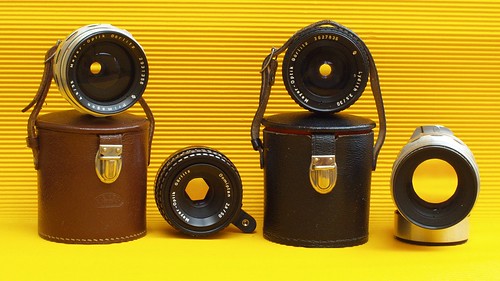
|
| Meyer lenses: Primagon, Domiplan, Lydith and Trioplan image by Uwe Kulick (Image rights) |
Meyer was a German optical company, founded in 1896 by Hugo Meyer in Görlitz. Besides Carl Zeiss Jena and Schneider Kreuznach it was one of the leading German lens makers in the 20th century. Meyer products were imported into the UK by the London company Roth, while Meyer had a US company, Hugo Meyer & Co., Inc. of New York, and Meyer rangefinders for press cameras and some other accessories are US-made. A few (very few) German-made lenses are engraved for Hugo Meyer & Co., Görlitz & New York.[1] In 1946 Meyer became VEB Feinoptisches Werk Görlitz (state owned company) and was merged in 1968 onto VEB Pentacon Dresden. The name Meyer disappeared from the lenses in 1971, all were branded Pentaconar, simple Pentacon or later Prakticar. After the German re-unification in 1990 the company had a short life as Feinoptisches Werk Görlitz GmbH until bankruptcy in 1991. In 2021 the brand Meyer Optik Görlitz was revived, with lens production in Hamburg, Germany, though (see below).
Contents
History

|
| Plasmat image by rebollo_fr (Image rights) |
Hugo Meyer (born 21.05.1863, died 01.03.1905) did an apprenticeship as an optician in Potsdam (1878-1882) and later worked at Ernst Leitz in Wetzlar (01.06.1885-01.02.1889). In 1894 he became factory manager at the Werkstätte für Präzisions-Optik Oscar Simon in Görlitz.[2] Oscar Simon moved his workshop to Dresden in 1896 and Hugo Meyer took the chance to establish his own company Optisch-mechanische Industrieanstalt Hugo Meyer &Co., Görlitz. His companion was the merchant Heinrich Schätze. [3] After his early death (41 years) his sons Hugo, Erich and Harry became joint owners and managed the company until 1945.
The first patent of the company (DRP 125.560, 1.06.1900) [4] was about the 4-lenses anastigmat Aristostigmat, which was offered initially with f/7.7, later f/6.8 and eventually with f/5.5. These lenses and the Schnellarbeiter (f/3) laid the foundation of the success development of the company. In November 1911 the competitor Schulze & Billerbeck was acquired, who just moved to Görlitz from Berlin one year before. Their Euryplan lens series was later added to the Meyer lens portfolio. [2]
In 1916 the Trioplan was launched, which became the basis for many Meyer lenses to follow. In 1918 Dr. Paul Rudolph, the inventor of Zeiss' Tessar and Protar, developed Meyer's Double Plasmat which was derived from the symmetrical Euryplan lens. In the 1920s he developed fast variants, the Kino-Plasmat f/2 and the World's fastest lens of its time, the Kino-Plasmat f/1.5. Another important step was the delivery of OEM-lenses for camera manufacturers - such as the Exakta from Ihagee. In the 1930s Meyer-Optik already had a wide range of high-quality interchangeable lenses. Compared to Carl Zeiss Jena, who was a market leader at the time, the lenses were usually offered at a slightly lower price.
After WWII, in 1945 all machines and technical equipment were dismantled and taken to the Soviet Union. In 1946 a laborious rebuilding of production began and the company was nationalized under the new name VEB Feinoptisches Werk Görlitz. Initially, the lenses still carried the Brand Meyer-Optik. Meyer was clearly the second East German lens supplier after Carl Zeiss Jena. In mid 1960s Meyer introduced lenses with interchangeable adapters for different camera types. The first such a lens was Orestegor 4/200, which could be mounted on Exakta Varex, Exa II, Pentacon, Praktina and Praktica 35 mm cameras with applicable adapters. Orestegor 5.6/500 could be mounted on Exakta Varex, Exa II, Pentacon, Praktina, Praktica as well as Praktisix medium format SLR. In 1968 Meyer became a part of VEB Pentacon and from 1971, all the Meyer lenses were branded Pentaconar, simple Pentacon or later Prakticar.
After the German re-unification, Meyer-Optik was separated from the Carl Zeiss Jena combine and relaunched as Feinoptisches Werk Görlitz GmbH. Lenses with the imprint Meyer-Optik were produced again for a short time until the company's bankruptcy in 1991. In 2014 the brand management company Globell revived the brand on the Photokina. Later the new technology company net SE announced the production of the new Meyer lenses in cooperation with original Meyer optics engineers from Görlitz. In 2018 OPC Optics, a maker of special lens elements based in Bad Kreuznach, bought the brand from the bankrupt net SE. Since August 2021, Meyer Optik Görlitz has again been operating as an independent company (under the roof of OPC as parent company). Another important milestone was then in November 2021, the start of its own manufacture in the heart of Hamburg. [3]
Meyer lenses
For lens serial numbers see THIS page.
| ||
| ||
|
- Aristoplan
- Aristogmat
- Aristostigmat
- Diaplan (projection lens)
- Double Plasmat
- Domiplan
- Doppelanastigmat
- Doppelplasmat / Double-Plasmat
- Epidon
- Euryplan
- Euryplan-Satz
- Helioplan
- Kinon Superior (projection lens)
- Kino-Plasmat and Kinoplasmat
- Lydith
- Makroplasmat
- Megon
- Omin (projection lens)
- Orestegon
- Orestegor
- Oreston
- Orestor
- Plasmat
- Plasmat-Satz
- Porträt Trioplan
- Primagon
- Primoplan
- Primotar
- Repro-Plasmat
- Satz Plasmat and Satzplasmat
- Telefogar
- Tele-Megor and Telemegor
- Trioplan
- Triotar
- Veraplan
The production of the lenses marked Domiplan, Oreston, Orestegon, Orestor, Orestegor, Lydith was continued when Meyer was incorporated into Pentacon. The lenses except the Domiplan lost their trademark names when they became Pentacon lenses.
"new products" of net SE
- Figmentum (basic line of quite fast sharp lenses, rebadged and repriced Zhongyi lenses)
- Nocturnus (very fast normal lenses, rebadged and repriced Zhongyi lenses)
- Somnium (fast special-bokeh portrait lens, rebadged and repriced Helios lenses)
- Trioplan (classic portrait lens)
See also
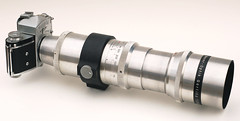
|
| Exakta SLR with Telemegor image by John Kratz (Image rights) |
The links go directly to the Meyer section:
Cameras
Cameras with a fixed Meyer lens
- Baldi
- Balda Baldaxette
- Balda Beltica
- Balda Super Baldina (folding)
- Balda Super Pontura
- Beirette
- Certo Dollina I
- Certo Dolly
- Certo Super Dollina
- Certo Durata II
- Certo Super Sport Dolly
- Meyer Megor (Korelle 3x4 variant sold by Meyer)
- Pentacon electra and Pentacon electra 2
- Penti
- Pentona
- Welta Welti 1
Other products
|
|
- Coupled rangefinder for press/field cameras, such as the Busch Pressman shown here.
The RF's lever arm bears on an attachment on the focus rails, so it doesn't require a 'rangefinder-coupled' lens. It was advertised for users to fit to their own camera.
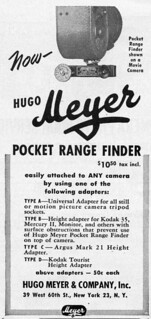
|
| Meyer Pocket RF. US Camera Oct 1949, p110. scanned by steevithak image by camerawiki (Image rights) |
- Pocket rangefinder
- Megoflex shoe-mounted focusing reflex finder for the Leica I, Contax and Nagel Pupille; effectively makes the viewfinder camera into a TLR; about 1930[5]
The 1936 US catalogue linked below lists focusing loupes, filters, supplementary lenses, tripod heads, accessory viewfinders and even front-mounted shutters.
Sources and References
- ↑ Double Plasmat engraved for Meyer Goerlitz & New York, in a forum post at Photrio. The spelling 'Görlitz' has also been seen, on lenses sold at Ebay.
- ↑ 2.0 2.1 Hartmut Thiele, Die Deutsche Photoindustrie - Wer war Wer, 8th edition, Munich 2021.
- ↑ 3.0 3.1 History section at Meyer Optik Görlitz Web-site
- ↑ DRP125560 at German Patent and Trademark Office]
- ↑ Megoflex focusing reflex finder with a Leica I, sold at the 43rd Leitz Photographica Aution, in November 2023.
- Fincke H.E.: Das Objektiv deiner Kamera; Fotokinoverlag Halle, Halle, 1959.
- Naumann H.: Das Auge meiner Kamera; Verlag von Wilhelm Knapp, Halle (Saale), 1951.
- Puskov V.V.: Poradnik fotograficzny; PWT, Warsaw, 1956.
Links
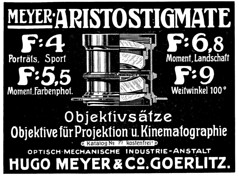
|
| image by Uwe Kulick (Image rights) |
- History on company homepage
- Hugo Meyer prewar catalogues at Camera Eccentric:
- 1930 Cine lenses: Kino-Plasmat, Trioplan, Tele-Megor and Makro-Plasmat
- 1936 Catalogue of photo lenses giving Roth of London as sole British agent.
- 1936 US price list of lenses and accessories incl loupes, tripod heads, shutters etc.
- 1938 Photo and cine lenses; eight-page advertising spread in the British Journal Almanac
- 1952 Large-format lenses (in German)
- Meyer Gallery at www.mflenses.com
- Hugo Meyer cine lenses company history and list of cine lenses
- Hugo Meyer in Stadtwiki Görlitz (in German)
- Meyer lenses for the original Exa and Exakta cameras on Photobutmore.de (in German)
- About net SE's newest "Germanifications"
- Note to the press: OPC takes over the camera lens brand Meyer Görlitz, December 2018.

